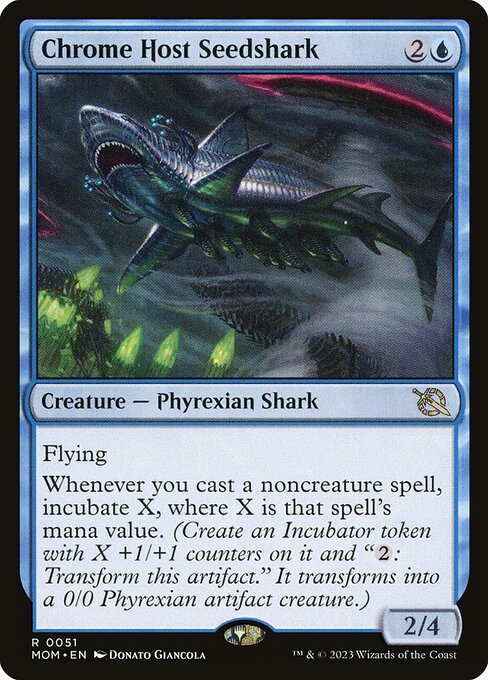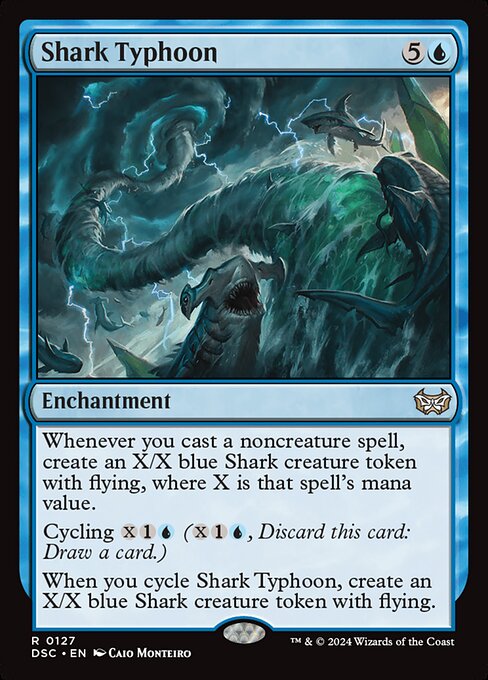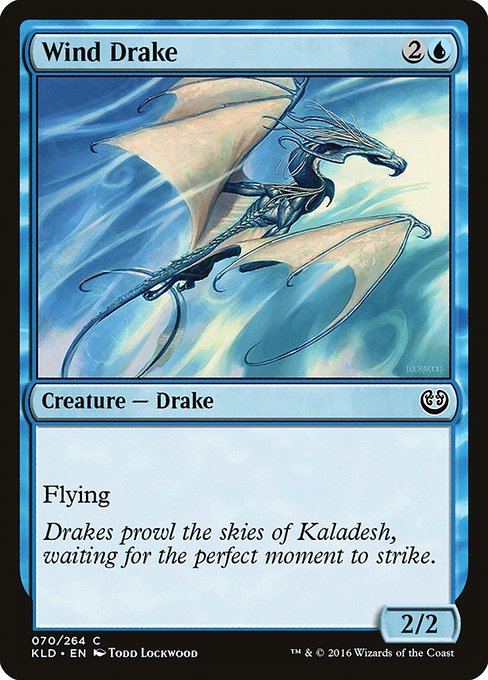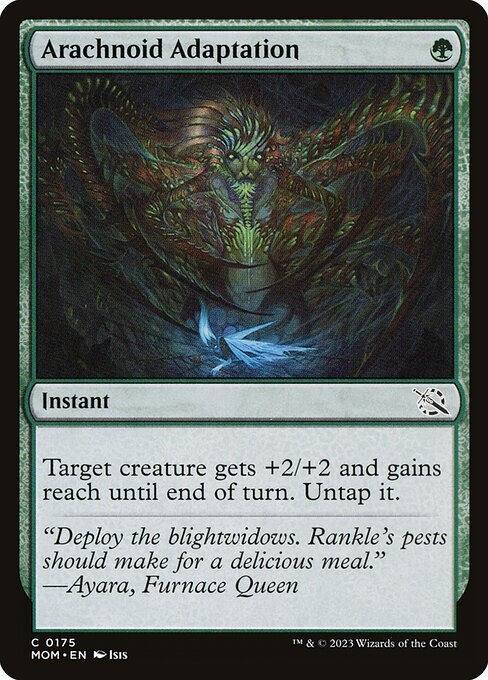In the deluge that is modern Magic, it’s important to pause on certain cards and consider them from all angles. Every card in every set is deliberately chosen for the role it fills in the Limited format and the strategies it enables in Constructed–each card, from 15th-pick commons to set-selling mythic rares, exists for a reason. Every aspect of every card, from casting cost to effect to name, is weighted not in a vacuum, but against the totality of the set and the environments it’ll affect.
I can’t imagine how many hundreds of hours went into testing Liliana of the Veil to make certain she wasn’t going to warp Pioneer or necessitate more Standard bans or how many tweaks go into complicated cards like the flip Praetors from March of the Machine. I do know that it’s worth honoring that work by reviewing the more interesting cards from each set and considering them both within the context of their sets and as standalone artifacts. For example, I’ve recently been taken with March of the Machine’s Chrome Host Seedshark, which is fascinating on its own merits and as a part of Magic’s history that tracks back to Ikoria’s Shark Typhoon, and even back to 1994’s The Dark.

Shark Typhoon is, first and foremost, a deeply silly card. Silly in flavor—inspired by artificial pseudo-cult object Sharknado—and silly in practice, as it either pumps out an insurmountable air force of Sharks or Cycles away mid-combat to 2-for-1 an opponent. I loved it in Ikoria Limited, I loved it in Ikoria–Zendikar Rising Standard, where I ran creatureless Dimir control, and I love it in various Cubes to this day. It plays well with cheap spells, but it truly shines with expensive cards with cost-reducers built in like Delve cards, split cards, and pitch spells. Chrome Host Seedshark riffs off of Shark Typhoon, but in a suitably Phyrexian way. It’s not a subtle reference (the current crop of Phyrexians aren’t about subtlety), but there is nuance in how the Shark has evolved with the influence of the Chrome Host.
Sharks have been a creature type in Magic almost since the beginning—decades before “Phyrexian” became official, and tracking back all the way to 1994. The Dark gave us Giant Shark, a flavorful and distinctly mediocre card, and Stronghold gave us Hammerhead Shark, a technically undercosted and taxonomically correct Fish. Amusing, within the subset of Magic’s eleven Sharks, only five are actually pure Sharks—most are Simic hybrids like Sharktocrab or chimeras like Shabraz, the Skyshark. Others are Fish that have been errata’ed now that Shark is once more embraced as an official creature type since Ikoria—Shark Typhoon setting the trend once again.
It’s the combination of “Phyrexian Shark” that nails why Magic is unbeatable—even if you know nothing about Magic or its lore, the archaic and alien feel of “Phyrexian” clangs against the eternal cool of “Shark.” One of my secrets as a Magic writer is my back-pocket test: if I want to gauge a reaction to a card after I’ve finished analyzing it, I show it to my eight-year-old Pokémon-obsessed nephew. He doesn’t play Magic, but Chrome Host Seedshark drew a “whoa!,” putting it in the rarified echelon of rainbow holo foil Mew and Thundering Raiju. It’s that mix of unfamiliar and familiar that hooks people—much as Magic initially succeeded by fusing random game outcomes with familiar tropes of European fantasy, modern Magic succeeds by grafting its ruleset to modern archetypes. March of the Machine is simply a multiverses-clashing superhero story that follows a modern mass culture trend, from Avengers: Endgame to Everything Everywhere All At Once. It may be trend-chasing, but Magic’s collection of universes is large enough that it’s relatively believable that a glowing blue Wizard could team up with a hundred-story nature elemental against a flying shark and its squadron of oily necrobots.

Magic also sells the more absurd aspects of its worlds through its art. Donato Giancola is a master, so of course his art is wonderful and disgusting—the Incubator pods latched onto the sharks’ belly like remoras; the Gitaxian eyestalks like a hotrod version of The Thing; the smeary gleam of reflected crystalline light from the shark’s underside. The Chrome Host, the blue-aligned Phyrexian army under the control of Jin-Gitaxias, appear to be invading Ikoria, judging by the crystals, but the sickly phosphorescence of the light, contrasted against the muted blues of the shark itself, also suggests the noxious mists of the Mephidross, as depicted in cards like Toxic Nim and Dross Harvester.
The contrast–let’s call it “noxioscuro”–lets the glowing crystals glimmer off the cloud-shrouded body of the shark, and spotlights it with diagetic light. Giancola’s cheeky nod to the Typhoon in the funnel cloud behind the seedshark helps tie the references together while subtly making the shark the center of the composition. The regularity of the human-built structures balances the chaos of the sky—the eldritch portals, the tornado, the swirling winds buoying the Phyrexian Shark. Note also how carefully designed the Shark itself is—the flexibility of its plates, the way the tips of its fins rake back, the way its gillslits blend into the striations of its body. Sharks have been around for 300-plus million years without needing to evolve much—even Phyrexia and the meritocratic eye of Jin-Gitaxias can’t do much to improve on nature’s design, so Donata Giancola sticks closely to Earth sharks. Whereas the Shark Typhoon was a quasi-natural phenomenon, this shark is a perversion of nature.

Interestingly, where the Shark tokens from Shark Typhoon had square stats (that is, X/X), the Seedshark has a surprisingly beefy backend. Wizards could have easily made this a 2/2 for 2U—classic Wind Drake stats—and yet, they chose to boost its toughness all the way to Azure Drake territory with a one-mana discount. I don’t mind “power creep” when it obsoletes cards that were never close to good enough, but I did have to read the card twice when an opponent first dropped it against me. Blue’s only three-mana 2/4’s printed prior to 2019 were Tolarian Drake and Wormfang Turtle, both of which have severe drawbacks and look comedically puny in the bright light of post-Modern design.
A Flying 2/4 for 2U isn’t precisely Vorinclex, but it does represent another point of precedent in the acceleration of creature stats. Interestingly, by being bigger, the Seedshark leads to greater in-game tension. That 2/4 body tells you to block your opponent’s 3/3 every time, but what if they have Angelic Intervention? You’re going to risk your Shark and the inchoate army it represents? If you drafted Seedshark, it’s presumably an important part of your deck, and you’d rather take the damage than jeopardize your deck’s engine. Darting in for two in the air has been a staple of Limited since Limited was invented, but what if they have an Arachnoid Adaptation/mtg_card] for their [mtg_card]Khenra Swiftspear? Part of the beauty of Shark Typhoon was the security of it being an Enchantment—you could either Cycle it at instant speed for a cantripping Shark when their shields were down, or cast it with the awareness that Limited decks run minimal Disenchant effects. Seedshark is more fragile–cheaper, certainly, but prey to Vanquish the Weak, Deadly Derision, or Shatter the Source.

There was a time—very long ago—where control decks sought resilient, non-interactive threats. Back then, they didn’t really care about size—the point was that they could overwhelm an opponent with card advantage, counters, and removal, so they could essentially win with anything, although Serra Angel was the classy choice. Control decks eventually moved to the massive, sticky threat model and used cards like Morphling and Simic Sky Swallower, but back in the Mirage-Tempest era, mono-blue decks won with glacial card advantage (including from actual glaciers—Thawing Glaciers) and with animated lands like Stalking Stones and Faerie Conclave. Those decks’ designers couldn’t imagine a threat like Seedshark, who is not only an evasive ten-turn clock, but gives all your non-creature spells delayed Kicker (2) to create a body. Finkelian Forbidian decks would covet the Seedshark, but twenty-five years of time have done what a quarter-century is bound to do and it’s unclear whether Chrome Host Seedshark will be anything more than a curiosity and high pick in March of the Machine Limited.
Chrome Host Seedshark is a dense card. It’s not inelegant, as it basically fuses a Prowess trigger with a set mechanic, so once you know the basics, you can predict the outcomes, but it does require a fair amount of maintenance. There’s a triggered ability that produces a new kind of token with an activated ability that can become a creature at instant speed with broad applications based on hidden knowledge–i.e., what non-creature spells you have in your hand. I’ve grown more fond of MoM Limited that I expected—the combination of Incubators and the Phyrexian mana cycles (Tarkir Duneshaper and friends) mean there’s a surprising amount of flexible Kicker-style mechanics in the set that let you spend your mana efficiently and scale up as the game goes on
The infusion of powerful Legends and the double-faced Praetor cycle means it’s a bit more bomby than I usually like, but sometimes the bombs fall in your favor. More than anything, I’ve been impressed by Incubator tokens–like Clues and Food before them, they’re a minor but appreciated way to smooth your turns out and they allow you to create an army without overextending. Seedshark has been the crux of the best of my Incubator decks, and I’ve developed a fondness for the card that mirrors the love I had for Shark Typhoon–it’s interesting how a connection can deepen your appreciation for an overperforming card. As an evolution, and not just a callback, Chrome Host Seedshark shows how Magic changes for the better: it’s referential, scalable, and powerful, but plays well independently of your knowledge of past cards.
Rob Bockman (he/him) is a native of South Carolina who has been playing Magic: the Gathering since Tempest block. A writer of fiction and stage plays, he loves the emergent comedy of Magic and the drama of high-level play. He’s been a Golgari player since before that had a name and is never happier than when he’s able to say “Overgrown Tomb into Thoughtseize,” no matter the format.

